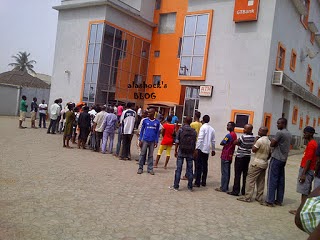“Making money is like digging with a nail,
while losing money is like pouring water on the sand.”-Japanese Proverb
Just the other day, I was
at the airport and needed some cash to pay some bills. I figured there was an
Automated Teller Machine within the terminal and quickly paced towards it to
withdraw the cash.
I had intended withdrawing
just N 3,000, but on getting there,
without even thinking properly, I withdrew N
5,000!
I didn’t mention that I met a small queue of persons already there waiting out their turns to use the machine. This familiar is one we’ll easily find across any ATM point located on any busy street/location in any part of the country.
I didn’t mention that I met a small queue of persons already there waiting out their turns to use the machine. This familiar is one we’ll easily find across any ATM point located on any busy street/location in any part of the country.
Right there, the thought
struck me that millions of people use the ATM on a regular basis–for some folks
up to 3, 4 or even 5 times in one day! Relating my experience at the ATM to
those of other users, it dawned on me that the ATM Card in some subtle an
usually unnoticed way makes us spend more money than we intend.
Have you ever been to a
shopping mall or supermarket and found yourself spending more money than you
originally planned for without even knowing, all because your ATM Card was
accessible, and you had some money in the bank? Sometimes, even when we notice
that we’ve overshot our budget, we tend to justify our spending by saying
things like “Well, I really need this” or “Let me just get them now they are
available before the get out of stock or become more expensive anyway”. Sound
familiar?
These days, even the bank
urges us to spend more, and a little more, and then some more, and they tease
us with freebies, promos, gift items, special treats and all that vain stuff.
<Like are you dumb?> Lots of times, we make our withdrawal decisions not
really on how much money we intend to spend or how much we have, but rather we
spend more on the basis of how much cash we can handle (convenience) and how
easily we have access to this cash.
We may have experienced
instances where we go to a shop/vendor with N
1,000 intending to buy things worth say N
650-750, but end up spending the whole cash because we couldn’t get “change”
from the store/vendor and were compelled to buy more. Sometimes, it’s the
feeling of worthlessness associated with receiving a low value currency (say N 100 or N200);
other times, it’s the shop/vendor who purposely hoards the change in order to
get you to buy more than you planned. Getting change in itself is another
matter altogether as some vendors and shop owners capitalize on this to keep
draining their customers.
There are times when we
would have loved to withdraw say N
7,500 or even N 500 (in dire cases) but
have difficulty doing that as the ATM may not be able to dispense exactly the
amount we want and we are compelled to round off the figure to the nearest
whole.
As much as the ATM and POS
technology have made payment and collection a whole lot easier for everyone,
they also have created a huge spending problem for people. Sadly now, a lot of
people do not save money and put the blame on the ATM as being the cause of
their problem. Many people have become self-inflicted victims of what I would
call the “ATM Spending Problem”–and
this cuts across both high as well as low income earners.
A few suggestions on what
one can do in order not to become a victim of the ATM spending problem:
1. Save First: It is
always advisable to pay yourself first before you begin spending, whenever you
earn money. That way, you only get to spend what’s left after you must have
removed your savings.
2. Put The Money Away: Ideally,
if you really want to save, it’s best you put the money away in a different
bank account perhaps with limited or no immediate
access to you.
3. Do NOT always carry your ATM: You can leave your ATM Card at home when you know
you have all the cash you will need with you. This helps most especially when
we feel that temptation or flashing urge to spend impulsively or buy something
we see on an outing that we had no plan of buying.
4. Prepare for Emergencies: Rather
than always carrying around your ATM Card, why not prepare for some small emergencies by carrying just a
little extra cash, especially when travelling. You can always keep away the
extra (if you don’t eventually spend it) for use another day.
I
thought about destroying all my ATM Cards some time, just to prevent me from
spending more than I should–totally unnecessary. So I came up with a few
solutions which I’m currently practicing–the suggestions I just share–since it
seems like the ATM is not my friend and a conspirator against my money!
© Precious Nwanganga 2014


















No comments
Share your view on this post...